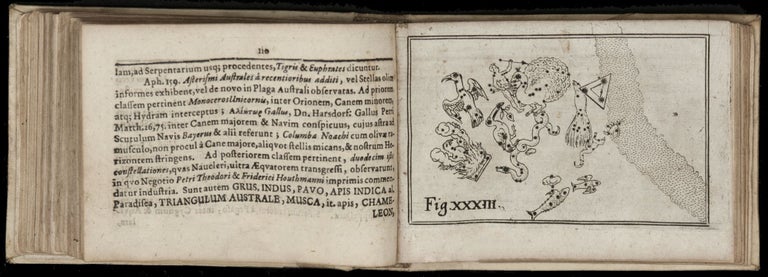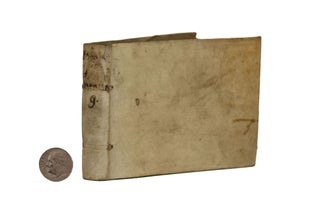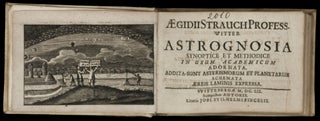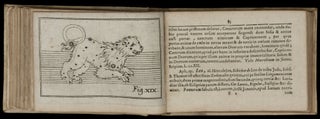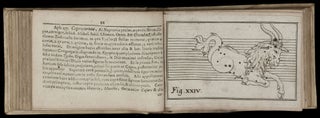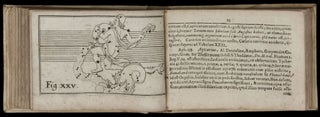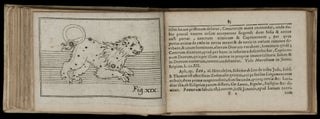Astrognosia synoptice et methodice in usum academicum.
Small oblong 8vo [10.9 x 7.4 cm], (1) f. engraved frontispiece, (4) ff., 160 pp., with XXXV full-page engravings (the last signed “Joh. Dürr sculp.”). Bound in contemporary vellum, title and self-mark in manuscript on spine. Binding very well preserved. Marginal annotation in title page, otherwise internally remarkably clean and bright with the engravings in fine, dark strikes. The very rare first edition of this extraordinary 17th-century pocket-sized star atlas designed for the use of students making nighttime observations in the field. Published during a time of remarkable astronomical discoveries after the invention and revolutionary use of the telescope by Galileo and his contemporaries, this handy guide became a hugely popular component in the 17th and 18th century stargazer’s toolkit, going through at least 6 editions. Illustrated with an (unusual) engraved frontispiece and 35 full-page engraved charts of constellations, the moon, the planetary systems, and planets, the Astrognosia is the work of the Wittenberg mathematics professor Aegidius Strauch (1732-82), who here demonstrates his command of the most recent research made using new telescope technology, including observations by Galileo, Kepler and Hevelius. Strauch dedicates his book to his students (mentioning several by name) and suggests that his work will be of great use to young scholars studying astronomy. The Astrognosia is partly based on Johann Bayer’s 1603 Uranometria, which Strauch credits. He mentions, however, that such atlases are both too expensive for most students and too unwieldy for “the observation of stars” (p.l. 3r) in the field. The book’s fascinating frontispiece neatly illustrates how Strauch hoped the volume would be used. In a nighttime scene (itself unusual in engravings of the period) set just outside the walls of a town (Wittenberg?), five figures are engaged in stargazing: In the middle distance, two collaborate over a quadrant while a third looks through a telescope of about six feet in length. This image ranks among the earliest published depictions of telescopic observational practice, and it is no doubt one of the most charming. In the foreground, two figures hold aloft a large, oblong-format book and examine it by candlelight, comparing its contents to the sky in front of them. Their book is labeled “Astrognosia Aegid: Strauch,” the very book the reader is consulting, but with its enlarged size cleverly demonstrating that the small format of the Astrognosia belies its great utility. The book is arranged in 171 numbered paragraphs that deal with astronomical terminology, theories of planetary motion, individual constellations, recent discoveries, and the like. The first engraved plate illustrates the Ptolemaic, Copernican and Tychonic planetary systems. Here Strauch mentions Galileo’s 1616 censure and 1633 trial, as well as the support of heliocentrism by Kepler, Lansberge and Descartes. There follow 32 engravings of constellations, the last of which is dedicated to stars of the southern hemisphere. Entries discuss observational history and are peppered with classical erudition. The final two plates are an image of the moon derived from Hevelius’s 1647 Selenographia, and a depiction of the planets Saturn (rings clearly delineated), Jupiter (with its 4 satellites), and Mars (seen in phase), all of which are the product of the telescopic revolution in astronomy. Strauch explicitly mentions the use of telescopes several times, e.g., in Galileo’s observations of the Pleiades (p. 79), Cancer (p. 82), the Orion nebula (p. 96), the Moon (122), the satellites of Jupiter (also seen by Simon Marius and Kepler, p. 122), and in Hevelius’s observations of the moon and the phases of Mars, etc. This first edition of the Astrognosia was financed by Strauch himself, but it apparently was a success and became a regional classic for many years. Later editions (which, sadly, abandoned the charming oblong format) appeared in 1668, 1678, 1684, 1694, and 1722, all published in Wittenberg and all quite rare today. Other than the present copy, which sold at Reiss in 2004 for 7000 euros hammer, we find no record of another copy of this first edition appearing on the market in many years. OCLC locates U.S. institutional copies at the American Museum of Natural History, Texas Tech, Adler Planetarium, and the Linda Hall Library. * R. Shirley, Maps in the Atlases of the British Library, vol. 2., p. 1359, no. C-STRA-1a; D. J. Warner, The Sky Explored, p. 247.
Sold

